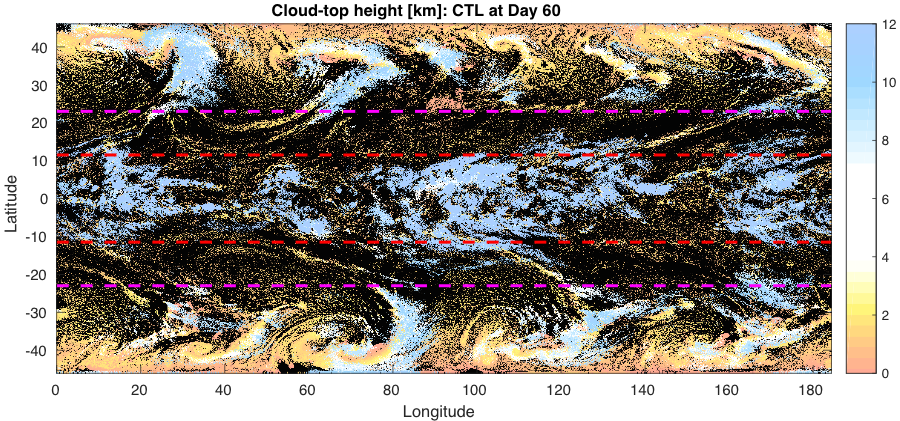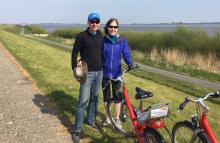Prof. Chris Bretherton spent his sabbatical year visiting three powerhouses of atmospheric and cloud modeling, the Department of Earth, Atmospheric and Planetary Science at MIT, the National Center for Atmospheric Research (NCAR) in Boulder, Colorado, and the Max Planck Institute for Meteorology (MPI) in Hamburg, Germany.
In Sept.-Dec. 2016, while at MIT, Chris was a Houghton Lecturer hosted by his doctoral advisor Prof. Kerry Emanuel, a world expert on hurricanes and cumulus clouds. He gave a series of lectures on cloud organization, cloud feedbacks on climate, cloud-aerosol-climate interaction, and global cloud-resolving modeling. He also visited Harvard, Yale, Columbia, and Stony Brook Universities, scaled most of the 4000’ peaks in New Hampshire that he had not yet visited, and lived with his 85 year old mother-in-law. The figure below shows the complex and realistic cloud patterns simulated by a numerical model with 4 km horizontal grid resolution covering a 20000 km long channel extending from 46 S to 46 N latitude above a water covered earth with an ocean temperature that roughly matches the earth but only varies with latitude. This model simulates individual thunderstorm systems as well as global weather patterns. We are using simulations like this to understand the intrinsic predictability of tropical weather phenomena and cloud feedbacks on climate change.

A snapshot of clouds simulated by a near-global model with 4 km horizontal resolution. Shading indicates the cloud-top heights, with blue being high (cirrus) clouds and yellow being low-lying clouds. The tropical rain belt lies between the red dashes and the subtropical dry regions lie between the magenta and red dashed lines. From Narenpitak, Bretherton, and Khairoutdinov, 2017 in JAMES.
In Jan.-Mar. 2017, Chris worked with NCAR scientists Andrew Gettelman and Kevin Raeder on ‘nudged hindcast’ simulations with the next-generation version of NCAR’s climate model, the Community Earth System Model. In this approach, the climate model is exercised as a weather forecast model, and its simulated clouds and aerosols can be compared directly with those observed by satellites or sampled by a research aircraft. Applied Mathematics graduate student Bethany Sutherland has recently begun analyzing these simulations as part of her M. S. thesis. While at NCAR, Chris also visited Scripps Institute of Oceanography, Caltech and JPL in California, and boned up on powder skiing, rock climbing and trail running.
In Apr.-May 2017, Chris and his wife Alison Cullen (a professor in UW’s Evans School of Public Policy and Governance) lived in a small apartment in Hamburg, Germany, becoming connoisseurs of fragrant cheese, marzipan, and mango cream sauce. Led by director Bjorn Stevens, MPI has made simulations of weather over all of Germany with a 150 m grid, an impressive computational achievement that allows almost photorealistic depiction of cloud formation processes. Chris worked with both students and research scientists there on understanding self-organization processes that help pattern clouds and humidity, as well as in understanding numerical convergence issues in simulations of certain cloud types. He also visited the Technical University of Delft in the Netherlands, Reading and Leeds Universities in England, and participated in the European Geophysical Union spring meeting in Vienna.
